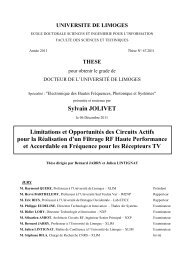Contribution à la conception optimale en terme de linéarité et ...
Contribution à la conception optimale en terme de linéarité et ...
Contribution à la conception optimale en terme de linéarité et ...
Create successful ePaper yourself
Turn your PDF publications into a flip-book with our unique Google optimized e-Paper software.
CHAPITRE II – CONSIDERATIONS GENERALES SUR LA LINEARITE DES AMPLIFICATEURS DE PUISSANCE<br />
Chaque raie cont<strong>en</strong>ue dans le trou peut être considérée comme une variable aléatoire<br />
<strong>de</strong> propriétés statistiques inconnues. Si nous faisons l’hypothèse que toutes les raies dans <strong>la</strong><br />
ban<strong>de</strong> c<strong>en</strong>trale suiv<strong>en</strong>t <strong>la</strong> même loi statistique, sont indép<strong>en</strong>dantes <strong>et</strong> adm<strong>et</strong>t<strong>en</strong>t une moy<strong>en</strong>ne<br />
m <strong>et</strong> un écart type σ , alors <strong>la</strong> variable aléatoire définie par :<br />
r PBruit<br />
− m<br />
PBruit<br />
= P suit une loi normale c<strong>en</strong>trée réduite.<br />
σ<br />
L’écart <strong>en</strong>tre le NPR calculé <strong>et</strong> le NPR réel (Inconnu) est égal <strong>à</strong><br />
ΔNPR<br />
= 10*<br />
log<br />
Pp<br />
P<br />
orteuse<br />
Bruit<br />
⎛ P<br />
−10*<br />
log⎜<br />
⎜<br />
⎝<br />
P<br />
Porteuse réel<br />
Bruit réel<br />
La variance du NPR est principalem<strong>en</strong>t due au calcul <strong>de</strong> <strong>la</strong> puissance <strong>de</strong> bruit<br />
d’intermodu<strong>la</strong>tion (moins d’échantillons <strong>et</strong> plus <strong>de</strong> s<strong>en</strong>sibilité <strong>à</strong> <strong>la</strong> répartition <strong>de</strong> phase) d’où<br />
⎛ PBruit<br />
réel ⎞ ⎛ σ/<br />
m r ⎞<br />
ΔNPR ≈ 10 * log<br />
⎜<br />
⎟ ≈ 10 * log⎜<br />
PBruit<br />
+ 1⎟<br />
⎝ PBruit<br />
⎠ ⎝ P ⎠<br />
La valeur prise par une variable aléatoire gaussi<strong>en</strong>ne a une probabilité <strong>de</strong> 99.5 % d’être<br />
compris dans un intervalle <strong>de</strong> ± 3σ<br />
.<br />
P r<br />
Bruit<br />
< 3σ<br />
= 3<br />
Si nous voulons que ΔNPR<br />
soit inférieur <strong>à</strong> 1 dB <strong>à</strong> 99.5 %, alors :<br />
⎛ − 3σ<br />
/ m ⎞<br />
⎛ 3σ<br />
/ m ⎞<br />
− 1 dB ≤ 10*<br />
log⎜<br />
+ 1⎟<br />
< ΔNPR<br />
< 10*<br />
log⎜<br />
+ 1⎟<br />
≤ 1 dB<br />
⎝ P ⎠<br />
⎝ P ⎠<br />
D’après [][] le rapport<br />
m / σ ≈ 0.<br />
75<br />
⎛ − 3 ⎞<br />
10*<br />
log⎜<br />
+ 1⎟<br />
= −1<br />
dB<br />
⎝ 0.<br />
75 P ⎠<br />
⎛ + 3 ⎞<br />
10*<br />
log⎜<br />
+ 1⎟<br />
= + 1 dB<br />
⎝ 0.<br />
75 P ⎠<br />
67<br />
⇒<br />
⇒<br />
P = 400<br />
P ≈ 240<br />
⎞<br />
⎟<br />
⎟<br />
⎠
















